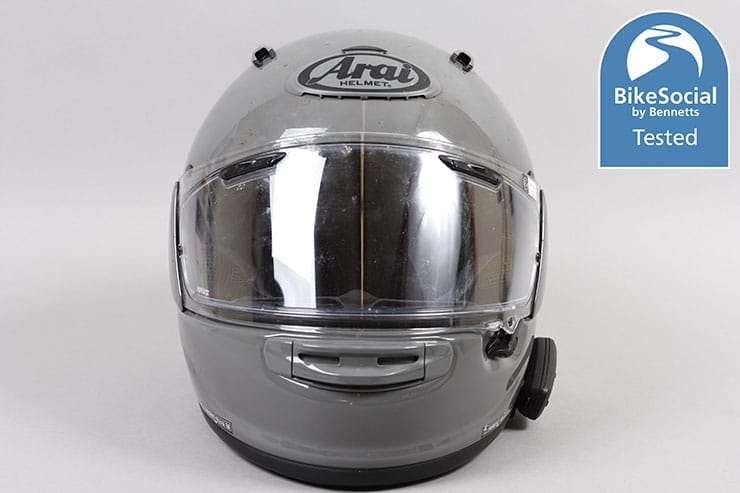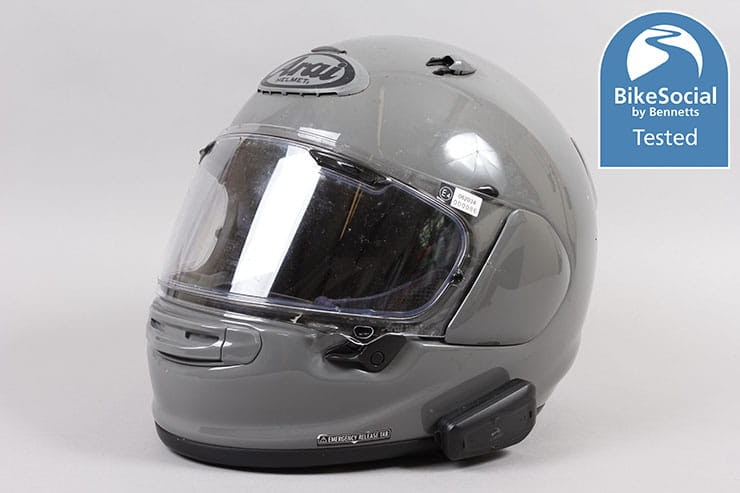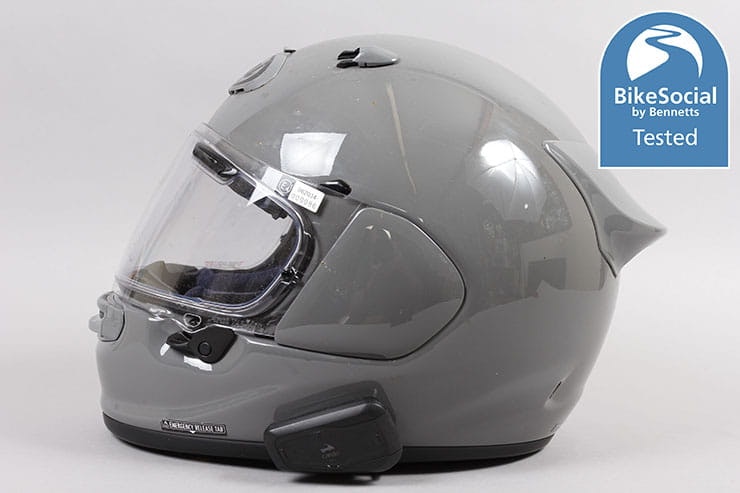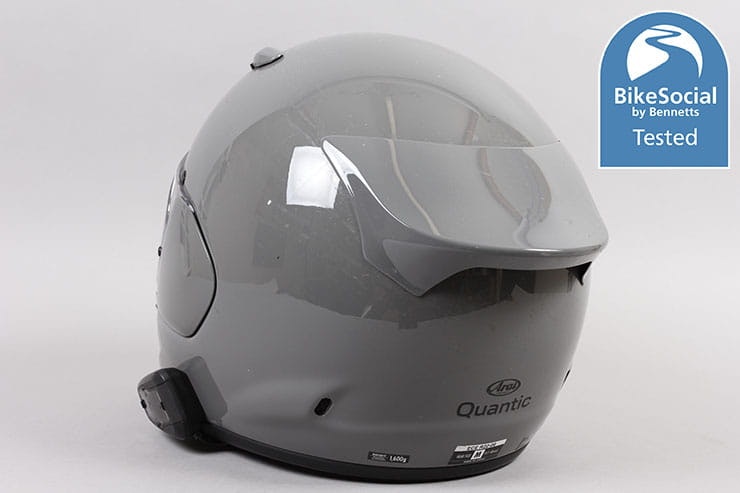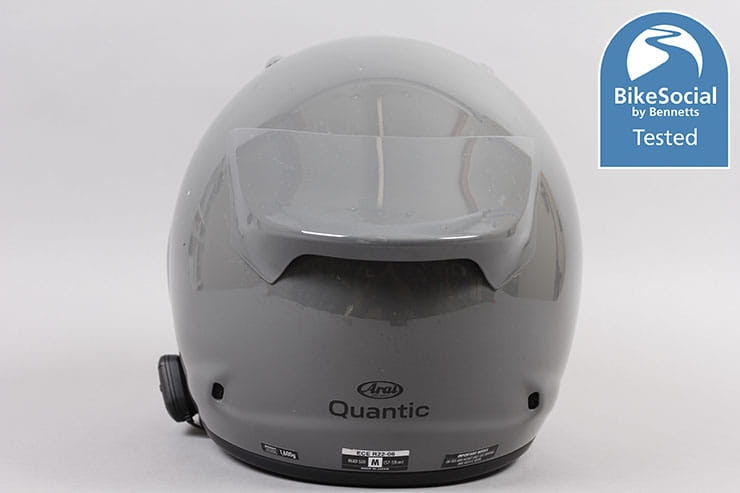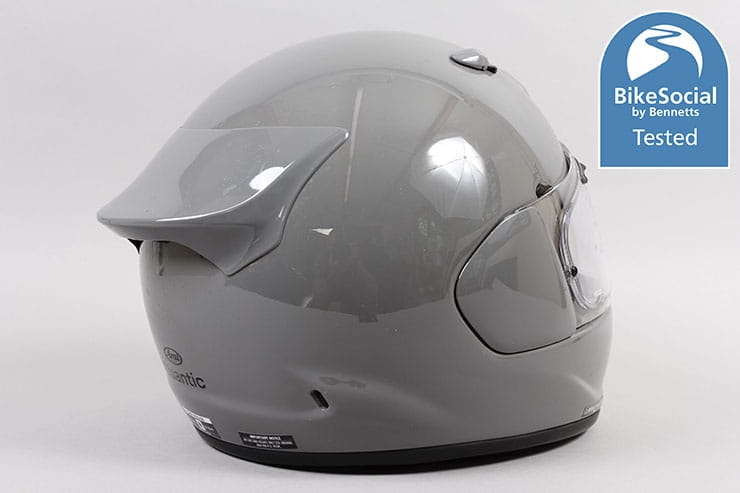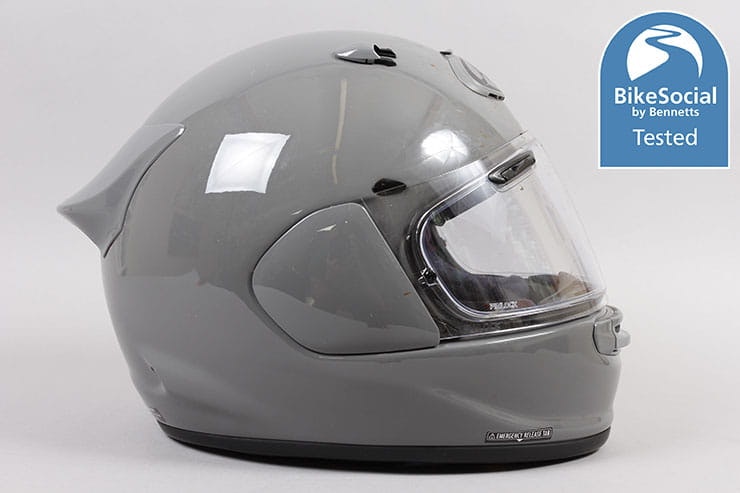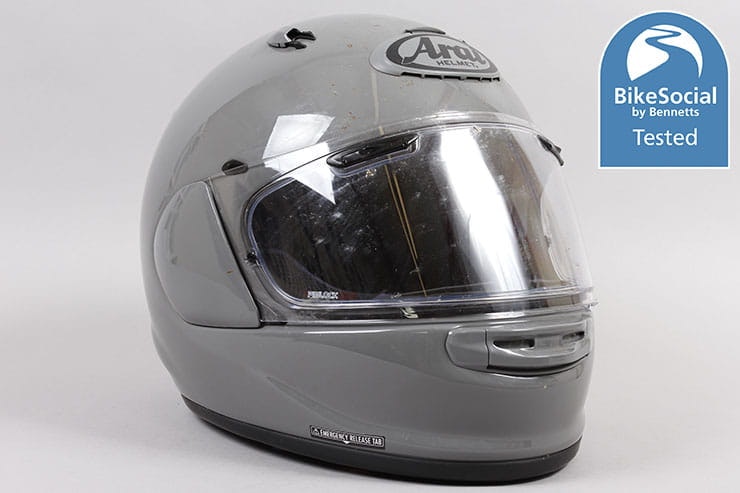Arai Quantic Review | First ECE 22.06 helmet tested
By John Milbank
Consumer Editor of Bennetts BikeSocial
02.10.2024
Date reviewed: May 2021 | Tested by: John Milbank | RRP: From £499.99 | www.whyarai.co.uk
The Arai Quantic on review here is not only an incredibly important helmet for Arai, but for all of us as riders because it’s the very first lid on sale that’s tested and certified to ECE 22.06, the new, tougher testing standard that includes a glancing-off impact and far more steps in the the procedure. Technically, that makes it the most provably safe helmet you can currently buy.
While my first impressions video at the end of this article also includes details of the new testing, I’ve been using the Quantic on a BMW S1000XR, 1999 Kawasaki ZX-6R and a Yamaha Tracer 9 GT on all types of roads in all conditions for more than a thousand miles to find out if this sport / touring helmet is worth the money…
UPDATE October 2024: After more than three years with the Arai Quantic, I can honestly say that it's my favourite motorcycle helmet thanks to the superb fit (for me at least - it's always subjective) and the outstanding ventilation.
Meets the toughest testing standards
Outstanding ventilation
Extremely comfortable with excellent aerodynamic
Would like option to close off direct-to-mouth vent
Still can’t easily open visor with my right hand
Can be slightly trickier to fit in smaller luggage
Outer shell
The Arai Quantic’s outer shell uses the company’s ‘Peripherally Belted e-Complex Laminate Construction’, which is a multi-fibre and resin shell that’s extremely strong, with additional layers for rigidity around the visor aperture and forehead vent area. This basically means that any impact is spread across the shell, before being dissipated by what can be a much softer (and hence more comfortable) inner expanded polystyrene (EPS) liner.
Whether a helmet with a hard outer shell and softer inner (like an armadillo) is better than a softer outer and tough inner (erm, a honey badger?) is the subject of much online debate. Personally, I believe in the idea of the hard outer shell that the premium brands use, and having been smacked on the head while wearing soft and hard EPS liners, I’m sticking with that.
Some will rightly point to SHARP test results, though newer Arais get four or fives stars in those government tests; have a look and you’ll see that there are very few recent models that have been tested, but the RX-7V is one, and that’s five star. As the interior and exterior shells are pretty much the same construction on all Arais (and the fact that this lid is tested to the most stringent standard available), I’m confident this will score well if/when it’s featured there.
Available in sizes XS to XL, there’s a separate outer shell for every two head sizes, meaning you won’t be stuck with a massive lid if you have a small head.
Arais are handmade in Japan with a strict quality control process that all adds to the cost, and the finish of the Quantic reflects that; while there are no graphics to peer at (they cost £100 more), the gloss is deep and every seal, piece of trim and vent is meticulously finished.
The large spoiler on the rear seems counter-intuitive when you think about the glancing-off tests that are so key to the new standard, but like all the vents, this is designed to break free in an impact. That doesn’t mean it’ll fall off though – while I wouldn’t recommend doing it, I’ve swung the Arai around by that vent and it’s shown no signs of shifting. This break-away principle has been used by Arai for years as it’s always claimed that the round helmet principle is best, and since the first Arai I bought in 1996, I’ve never had a vent fall off. And if it did, Arai would replace it. Oh, and you can also get your Arai serviced by the race team for free at many shows, when they start up again.
The only slight grumble I have with the design of this helmet (and the grey really has grown on me) is that the wing can make it a little tricky to get it into smaller luggage. It will go in a Yamaha Tracer 9 GT pannier, but it takes a little jiggling.
Arai Quantic Weight
Claimed to weigh 1,600g, unusually this medium comes in just under that at 1,588g on my scales. That’s heavier than some still, though I can honestly say that I have yet to wear any lid that’s a problem for weight once it’s on, despite what it says on paper and how they feel in the hand by comparison.
What can be a problem with some helmets is the wind trying to grab it at speed, especially when turning your head for a shoulder check; here the wing seems to work exceptionally well, with pretty-much even pressure whichever way I look.
Ventilation
The ventilation is outstanding – the chin, two top vents and single exhaust under the wing have two positions plus closed; while not that easy to find the middle setting with thicker gloves on, they’re easy to operate.
The vent built into the logo on the forehead is open or closed, as are the two eyebrow vents on the visor. The two lower rear exhaust ports are always open, as is the venting built into the neck skirt.
With everything shut the Quantic is wonderfully draft-free and comfortable, but open each vent and you can feel the difference it makes, to the point that air really flows across your head, taking hot air with it – it can actually get too cold in spring with them all open, so the control is welcome.
The interior shows the eight ports in the EPS that help give exceptional ventilation
Having this potential for cooling is great, but it’s also not at the expense of ‘air pressure points’, with no feeling of annoying jets on any one location of your head.
The chin vent feeds air up and over the back of the visor, but it also directs it to your mouth. This is great in hot weather, though I’d have liked the option to close it off in front of the mouth and just have it feed the visor for winter riding. Though to be fair, the Pinlock takes care of misting and the air flow is regulated by a foam insert so I’ve not had a problem with it down to 10°C.
Visor
It’s great to see that the Quantic uses the same VAS (Variable Axis System) visors of other Arais of the past few years, so you can swap them around if you have a spare or a dark one.
Of course, some people will be disappointed that this is the same attachment system, which requires popping off the side pods before rotating the visor to the red dots and taking it off. Personally (and maybe it’s because I read the instructions), I have no problem with this, and refitting is just as simple, with no tools required.
I love the fact that an Arai visor can be positioned anywhere you want while riding, but you do need to keep the mechanism clean in winter. That’s only a matter of popping off the side pods then giving it a rinse though. At most, you might need to add a spot or two of the silicone that comes with the helmet.
The visor can be set cracked just open easily, but only with the left hand; it’s my only real pet-hate of this system that when you’re sat at traffic lights with the clutch held in, it’s very hard to flick the visor open with your right hand.
A top-of-the-range Pinlock Maxvision 120 anti-fog visor insert is supplied, and so far has been very effective in keeping the visor clear.
The visor seal works excellently – it is possible to adjust the visor mounting plates, but I had no need and have not once had any rain get inside (the problem area is usually along the top edge), even in a torrential one-hour-long storm and a two-day trip through Wales.
Lining
As expected, the lining is extremely comfortable. The cheek pads have removable foam patches to fit intercom speakers (I have a Cardo Freecom 1+ that I can’t feel is there), and it’s good to see emergency pull-tags to whip the cheek pads out in an accident, making it easier for someone else to remove the lid. They’re not as easy or neat as the straps fitted to Shoei lids, but at least they’re there.
The neck roll has a small opening that allows you to tuck spare intercom wire into if you need to, and this lid is clearly designed for your choice of comms, having a flatter section on the sides to more easily stick your unit. I do appreciate that Arai hasn’t gone down the route of making a lid that can only accept its own intercom.
While the cheek pads and skull cap are very easily removed for washing, it’s a shame the neck skirt is fixed in place as this can get grubby over time, so will be a little trickier to clean.
Also, while the chin skirt is effective, this too can’t be removed, though I can’t imagine needing this helmet any cooler once the vents are all open. If anything, I’d have liked to have seen the chin skirt just a touch bigger and a fraction tighter. I really am picking holes here as I’ve had no problems throughout its use except two instances on the ZX-6R that I could feel it just vibrate a touch on the underside of my chin.
Fastening
Fastening is with a double-D strap, which is very well made and easy to use, but you will struggle with gloves on. While I know many people prefer the fact that a secure fit is guaranteed every time, the latest micrometric ratchet buckles are a lot easier to use with gloves on, and potentially more suited to a sport-touring helmet.
Fit
The opening of the Quantic has been redesigned to be larger, making this much easier to put on than previous Arais. Some people may have been put off when trying one on as they can seem tight until your head pops in, but this is a lot more relaxed feeling, while still being extremely secure, at least on my head.
It doesn’t matter how much you spend on any helmet, you must try it on first, and you need to feel for any pressure points at all – something mildly irritating in store can be agony after an hour.
There’s no such thing as an Arai head or a Shoei head any more, but helmets do vary. For background, I find Arai and Shoei perfect, while Schuberth and MT can come up a bit small. LS2 fits me well, and only half the Shark range seems to be right for my head. HJCs are a bit tight on my cheeks, while AGV can be snug on my forehead at times. You really must try every helmet on, even if you’re confident in one brand.
With all that being said, I find the Quantic to be exceptionally comfortable and as a glasses wearer it’s absolutely fine, leaving them sitting correctly on my nose and with no undue pressure at the sides.
Noise
Every helmet needs earplugs, despite what the manufacturers say, and it’s the fairing on bikes that tends to be the root cause of most noise (wind-tunnel testing is done on an unfaired motorcycle).
I wear EarPeace earplugs as they’re comfortable and they allow my intercom to sound good (and of course I can easily hear horns and emergency vehicles), and the Quantic is extremely comfortable and as noise-free as I’d expect a quality helmet to be.
For more information on why earplugs are vital with any helmet, and advice on which are the best, click here.
Three alternatives to the Arai Quantic
At this price there’s plenty of choice, but the Quantic is – at the time of writing – the only helmet you can buy that’s tested and certified to the new, tougher ECE 22.06 standard. However, others you might want to consider are:
Shoei NXR2 (from £429.99). A close competitor to the Quantic, this also doesn't have a drop-down sunshield, but it is a far more racey, snug fit than the Arai. You can read the full review of the Shoei NXR2 here.
The HJC RPHA 11 Carbon is a high-spec helmet considering it costs from £349.99, though it does have its quirks. You can read the full review of the HJC RPHA 11 Carbon here.
The Shoei GT-Air 3 is more expensive than the Arai with an RRP starting at £529.99, but it does have a built-in sunshield, and it's a more relaxed fit, unlike the NXR2. Read the full review of the Shoei GT-Air 3 here.
These are just three of many alternatives – you can find all the helmet reviews we’ve carried out here.
Arai Quantic review: Verdict
At £500 for plain colours, this is a premium-priced helmet, but it’s very well made, is proven to be one of the safest you can buy, and comes with proper customer support.
There are plenty of other helmets out there that can be as comfortable for many people, or that offer great ventilation, or that feel as settled high motorways speeds, but the Quantic strikes a rare balance that makes it one of the best helmets I’ve worn, including the range-topping Arai RX-7V.
Yes, I have some small reservations, mainly around the visor catch and the skirts, but these are pretty minor points. This is a premium helmet, but it’s worth it.
UPDATE October 2024: After more than three years with the Arai Quantic, I can honestly say that it's my favourite motorcycle helmet thanks to the superb fit (for me at least - it's always subjective) and the outstanding ventilation.
Arai Quantic video review
First impressions, plus details of the ECE 22.06 testing standard
Best sport-touring helmet: Arai Quantic vs Shoei GT-Air 3 vs HJC RPHA 71 vs Shark Spartan GT
Four top-of-the-range full-face sport-touring helmets reviewed: Arai Quantic vs Shoei GT-Air 3 vs HJC RPHA 71 vs Shark Spartan GT Pro Carbon. They're all premium ECE 22.06 helmets, and in this video, we'll cover everything you need to know before deciding which is best for you.
